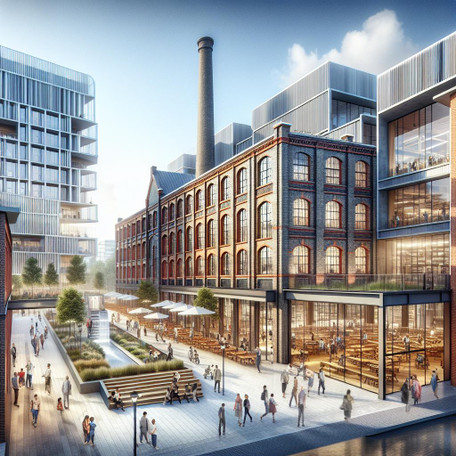Tom Dixon Coal Drops Yard: A Fusion of Industrial Heritage and Contemporary Design
Posted by Carl Jenkins - Senior Architectural Designer on Sep 28, 2024
In the ever-evolving landscape of urban renewal and architectural reinvention, the Tom Dixon Coal Drops Yard stands as a testament to the blend of old-world charm with modern aesthetics. A vibrant blend of historical significance and cutting-edge design, the yard is a paradigm of how spaces can be reimagined to serve new purposes while respecting their past. Let's delve into the dynamic narrative of Tom Dixon Coal Drops Yard, examining how it epitomizes a seamless fusion of industrial heritage with contemporary relevance.
The Rich History of Coal Drops Yard
Originally constructed in the 1850s, Coal Drops Yard served as a pivotal node in London's industrial network. It was a key part of the infrastructure that supported the city's rapid expansion during the Industrial Revolution, primarily used for receiving and sorting coal for distribution across the capital. The long, ironwork structures and brick-lined viaducts are still reminiscent of their origins, steeped in stories of the power and grit that drove Victorian-era London.
These buildings, with their utilitarian aesthetic, were not mere passive relics of the past. Instead, they embodied a spirit of industrial enterprise and innovation. Yet, as the city's needs evolved, so too did the purpose of these grandiose structures, adapting to new narratives and functions in the urban tapestry.
The transformation of Coal Drops Yard over the centuries has been profound. From its gritty, labor-intensive origins to its present-day elegance, the site encapsulates the very essence of London’s ability to reinvent itself. As industries waned and the demand for coal subsided, this architectural staple stood dormant, awaiting its next incarnation.
Tom Dixon's Vision for Reimagining Space
Tom Dixon, a name synonymous with transformative design, saw the potential to revive Coal Drops Yard as a beacon of contemporary creativity. This vision wasn't merely about restoring buildings but about reigniting interest in a forgotten industrial landscape, turning it into a thriving hub of cultural and commercial activity.
Dixon's approach is deeply aligned with the philosophy of respecting the existing urban fabric while injecting new life into it. By maintaining the essential structural integrity and historical details of the coal drops, Dixon ensured that the past remained visibly intertwined with the new future he envisioned for the space. The result is an aesthetic convergence where timeworn bricks and iron beams harmonize with sleek modern materials and innovative architectural touches.
Dixon's process of revamping Coal Drops Yard was not confined to aesthetic enhancement alone. It entailed a philosophical approach to design that harnesses historical context as an intrinsic element of modern functionality. His work echoes the larger conversation about ecological and sustainable urban development, repurposing existing infrastructure to meet contemporary usage demands while minimizing environmental impact.
Architectural Marvel: Design Highlights
The architectural highlights of Tom Dixon Coal Drops Yard are as much about preservation as they are about innovation. The redesign focuses on embracing the site's industrial heritage while introducing new elements that make the space vibrant and functional for contemporary uses.
- The Gasholders: These iconic, circular edifices were reimagined into modern office spaces and apartments, integrating state-of-the-art facilities while maintaining the original external structures.
- The Kissing Roofs: Perhaps the most visually striking feature, the roofs of the coal drops seem to kiss each other, serving as both an artistic statement and a practical setting for communal spaces that overlook the bustling yard below.
- The Waterfront: The proximity to Regent's Canal is maximized through outdoor terraces and pedestrian pathways, enhancing the urban experience by bringing people closer to the water in a symbiotic relationship between the city and its waterways.
Each of these elements speaks to the careful balance Dixon has achieved, honoring the past while crafting a forward-looking space that caters to modern expectations and lifestyle demands.
Design intricacies such as these reflect a perennial dialogue between form and function. The architectural reimagining by Tom Dixon engenders a profound appreciation for contextual storytelling through design, where every beam and brick narrate the site's storied past while celebrating its contemporary vitality.
An Urban Ecosystem: Cultural and Commercial Vibes
Tom Dixon Coal Drops Yard is more than just a collection of buildings; it is an ecosystem of community engagement and cultural exchange. The yard hosts an array of boutiques, eateries, studios, and flagship stores, each contributing to the vibrancy of the area. These commercial entities aren't just tenants, but participants in a narrative that celebrates creativity and innovation.
The space acts as a catalyst for cultural happenings, from art installations to concerts and public gatherings, providing a platform where creativity thrives in an urban context. This is reminiscent of Jane Jacobs' own appreciation for vibrant, diverse cityscapes where spontaneous interactions and community engagement form the lifeblood of urban vitality.
The successful fusion of cultural experiences and commercial vibrancy exemplifies Tom Dixon Coal Drops Yard’s role in catalyzing urban revitalization. Its success hinges on a multifaceted urban ecosystem designed not solely for retail, but as an experiential journey, a cornerstone of community and individual interaction.
A Case Study in Successful Urban Renewal
The success of Tom Dixon Coal Drops Yard can in part be quantified by its ability to attract visitors and residents alike. But beyond numbers, its real success lies in how it redefines urban space and the process of urban renewal. It stands as a study in how careful design can result in places that are both inclusive and complex, balancing the old with the new, and creating an enduring appeal that transcends generational divides.
Drawing parallels to Jacobs' advocacy for preserving the character of cities while nurturing their growth, Coal Drops Yard emerges as a tangible example of these principles in action, influencing other urban projects worldwide.
This vibrant nexus of activity is not only a testament to adaptive reuse but positions itself as an inflection point in broader urban discourse. Its philosophy can inform global perspectives on development, offering insights both theoretical and pragmatic for the conservation of industrial heritage and its harmonious coexistence with contemporary functionalities.
Preservation and Progress: A Reflective Conclusion
As cities around the world grapple with issues of modernization and heritage conservation, Tom Dixon Coal Drops Yard provides invaluable insights into how both can be achieved concurrently. It demonstrates that preservation need not hinder progress, and that even the most antiquated of spaces can find relevance in our contemporary world.
Ultimately, this urban gem showcases that the soul of the city is best maintained not by demolishing the past, but by elevating it, intertwining it seamlessly with the new. The Coal Drops Yard story is one that advocates for architecture as a living, breathing entity, continuously evolving while rooted deeply in history—a notion Jane Jacobs herself would champion.
The essence and narrative of Tom Dixon Coal Drops Yard underscore a philosophy of integration rather than isolation, illustrating that the dialogue between past and present can be both a poignant and pragmatic driver of architectural and urban innovation.







